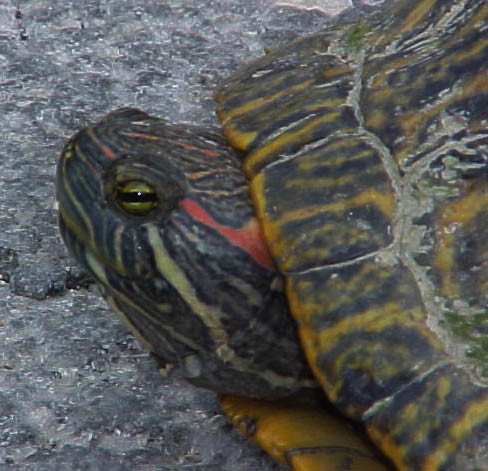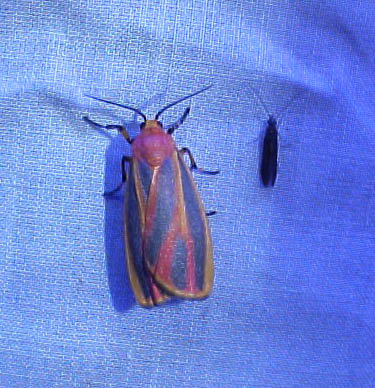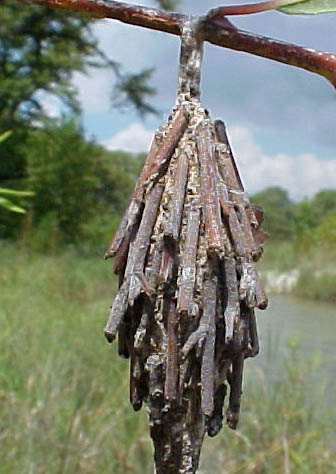© 2016-2022 - All Rights Reserved
Here are some pictures from this year (2016), just so you know there is all kinds of great stuff to see. It's just that I can't get good photos of it. These are just low-res docu-grab-shots or digiscopes from around the yard or 'hood, for illustrative purposes.
Quick links to the last few years ...
2015 pix
2017 pix
2018 pix
2019 pix
2020 pix
2021 pix
2022 pix

Eyed Elaterid, a giant (2") click beetle with big
false eye spots on the thorax, one of my favorite
bugs. We usually see a couple or few per year here.

This the second before it takes flight, wings extended,
and elytra (the hard protective forewing of beetles)
forward and out of the way. Hard to imagine those two
little hind wings give this 2" beast flight.
They sound like a bomber.
Keep in mind a bumblebee has four wings for power.

Pond (aka Red-eared) Slider - does not fly

Red-spotted Purple is an Admiral

Cloudless Sulphur on Dakota Verbena

"Spring"
Henry's Elfin on a Redbud

Crimson Patch caterpillar on Flame Acanthus (larval foodplant) at the library garden

Female Dobsonfly (not sure if we have Eastern (prob.) or Western
here). Note the nice-sized jaws. This is the first one I have
seen locally, and that only due to it being caught in a spider web.
The aquatic larvae is a serious predator, called a hellgramite.
They are similar to an antlion in appearance but much larger
and can have a 5" wingspan.

Blacktail Shiner (Cyprinella venustus), male in good color

Blacktail Shiner females are duller

Male American Robin


Male Golden-fronted Woodpecker eating sunflower seeds

This is a first-year male House Finch on Jan. 1

Common Ground-Dove

Male Vermilion Flycatcher

Lark Bunting about to crack a sunflower seed

This is how a Roadrunner acts when you do not need to see one

Juvenile Broad-winged Hawk July 22 on garden fence,
taken through window and screen.

Whazzat? A quiz bird. :P
(I will add answer in a few months)
This was a Bronzed (formerly called Red-eyed) Cowbird.
Without red eyes. It was sick.

Cave Swallow, juvenile in wing molt in July

A couple Cave Swallow, adult left, juvenile right

The Utopia Green Violetear June 8, 2016

The undertail of the Green Violetear June 9, 2016

A juvenile Painted Bunting

This is a one-year old male Painted Bunting just
starting to get some color on the underparts.

Adult male Painted Bunting

Purple Martin, wings are up behind back

A group of Purple Martin in various plumages

Turkey (left) and Black Vulture

Here is the business end of a 6 foot Texas Gopher Snake.
Quite the beauty I must say. A Cotton Rat eating machine.

Indigo Snake, which was over 5' long and eating a cotton rat.
Usually they just look black except at just the right angle.

Here it is in a dark corner where I had to use flash. The two bright spots on left are the nose. Mainly I wanted to show how they really show blue if the light is right, as you can see in some of the scales.

Porcupine

An Underwing (Catacola sps.) moth

This methinks is a Velvet Worm, was about 3" long and looked just like velvet.

This is a 2" Prionus (Cerambycid) beetle

This was a nice looking grasshopper, though likely eating something I want in the yard.

Owlfly are fast predators and sort of resemble small dragonflies.
But they have long antennae with knobs at the tip which you can
see against the car antenna below it.

Here are a couple pictures of the Frostweed when it splits open
and makes ice, or frost. Temps in teens or 20's F with
low humidity seems to do it. It is thin ribbons of ice that
freeze out of the stem which gets blown open in the process.

It only lasts a couple or few hours usually before it melts.
In a patch of them every plant has a unique pattern of the lacy
thin ribbon-like ice growths. A stem between a quarter and a half
inch thick can grow an inches-wide ice structure.

A Buprestid beetle

Thornbush Dasher, a less than annual dragonfly here

If you don't know which way to go, guide services are available. ;)

Lichen Moth (left) and a "micro" moth of which
there are hundreds of types here.
I don't do micros, you have to draw the line somewhere. :)

Bagworm. This is from a moth, the female is flightless and
lives in this bag. You might see these in trees along river.

This is an unknown type of caterpillar, presumedly a moth.
When you see these types with lots of long fuzzy hairs be
very careful, some are incredibly painful stingers.

Eastern Kingbird, you can see some old browner worn feathers
and some new fresh clean gray ones, so an adult.

I just love me some nice shrooms. One day I hope to put up a
whole page of shroom pix, there are so many varieties. Pretty
neat for a fungus! The big ones here were 4-5 inches across.

We had a nearly week long flight of a billion Snout (butterfly)
in September, this gives an idea of their numbers.

An adult Yellow-crowned Night-Heron, this was at
the Uvalde Nat. Fish Hatchery

Malachite at Utopia Park Sept. 23. The upper side is twice as bright
in color as the underside, which is essentially its camo mode.
Above they are bright lime green and dark chocolate, color is much
lighter below. Sometimes you take what you can get for photo docs.

Just to give an idea, here is a pic showing part of the yard, the house and cottage, so you can get an idea of where much of the stuff being written about is being seen. This pic is from May 2013, barely two months after we moved into this place. Now there are butterfly flowers around the porch. Yard lists are: about 40 species of odes (dragons), over 85 sps. of butterflies, 7 sps. of frogs & toads, 7 sps. of native lizards, 20 sps. of native mammals, about 100 sps. of plants (mostly wildflowers), and about 210 native species of birds, in 40 months so far.
~ ~ ~
Quick links to the last few years ...
2015 pix
2017 pix
2018 pix
2019 pix
2020 pix
2021 pix
2022 pix
If you have arrived here from our Bird Photos page, you may close your browser to return to the Bird Photos index.
Other visitors may click your "Back" button on your browser or select a link to keep visiting!

To Bird Photo Main Menu

To Butterfly Pics

To Dragonfly & Damselfly Pics

To Current Bird News
Birds
Utopia Birds
Birding Sites
Bird List
Bird Guide
Reports from Lost Maples
Winter Bird Count
Butterflies
Butterfly News
Butterfly List
Butterfly Photos
Rare Butterflies
Dragonflies
Critters, Bugs, & Stuff
Lost Maples
Garner State Park
Local Site Guide
Home

Our E-mail
mitch @ utopianature.com
 All photographs within this site are copyrighted
All photographs within this site are copyrighted